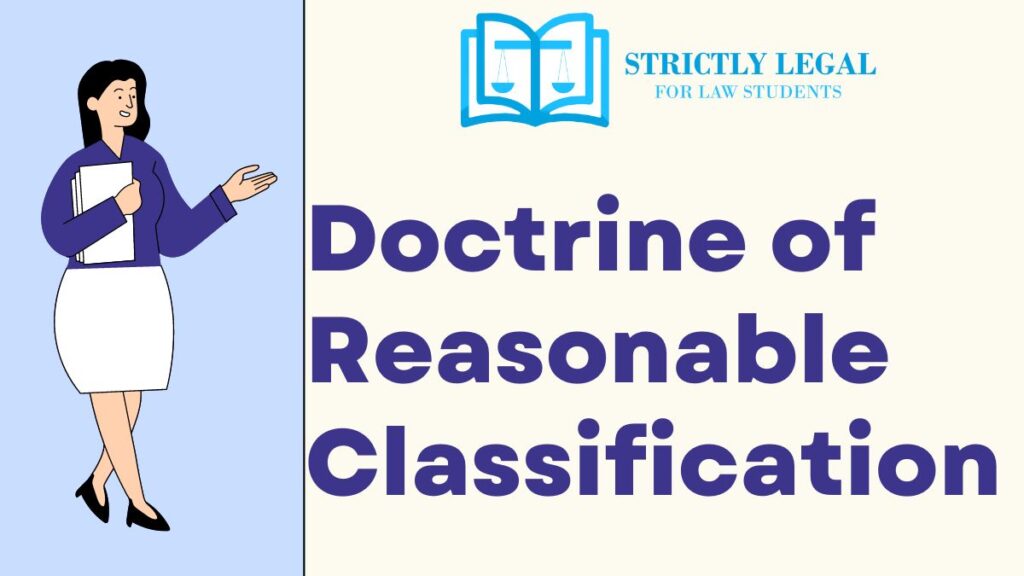The Doctrine of Reasonable Classification has been derived from Article 14 of the Constitution of India. Article 14 is one of the fundamental rights that are guaranteed by the Constitution of India and provides the right to equality for every citizen of the country. It surrounds the general principles of equality before the law and forbids unreasonable discrimination on the basis of religion, caste, sex, race, gender and place of birth between people. It assimilates the concept of equality that is expressed in the preamble. In addition to that, Article 14 has two features I.e., Equality before the law and equal protection of the law. In former days, a test was conducted to test if there is a reasonable classification of the legislation or it can simply be put as a test to check the constitutionality of constitutional validity. Such a test was called as Doctrine of Reasonable Classification.
Table of Contents
Equality Before Law
The term was originated from America and is an almost negative view of focusing on the implication of the absence of some special privileges. This can be by the reason of birth, religion, sex, caste, etc and by the ordinary law in favor of persons and all the equal subjects of classes. Article 14 of the Indian Constitution states that the State shall not deny to any person equality before the law or the equal protection of the laws within the territory of India. It can converse from this statement that not a soul is above the law of the land and the rule of law shall win as all are equal in the eyes of law. Nonetheless, this is no hard and bone rule and is subjected to various exceptions.
Equal Protection of Law
The term was originated from the Great Britain and is a positive concept in focusing on the equal treatment in identical situations. In simple words, it says that the President or the Prime Minister of the Country shall be dealt with in the same manner in law, as that of a common netizen.
Rule of Law
The Rule of Law in England called by Dicey is an aspect of the guarantee of equality before the law. This simply comes down to the point that no matter what is the rank of a particular person, his condition would still be subject to the jurisdiction of ordinary courts as no man is above the law. It is a requirement of the rule of law that no man should be subjected to uncivilized, discriminatory and harsh treatment. This would be applicable even when the objective is to secure a paramount need for law and order.
Rule of Law in India
Supremacy of Law
The very initial meaning is that in reality, no person is punishable or can be made to suffer legally. A person can be punished for the infringement of the law but cannot be held liable and punished for anything else. Except in the case otherwise, of a breach of law, a person cannot be punished. With reference to the ordinary procedure, an alleged offense needs to be proven in front of the court.
Individual Liberty
Article 21 of the Constitution of India guarantees the protection of life and personal liberty whereas Article 19 guarantees the right to freedom which specifies individual liberty like any other fundamental right. The constitution is the supreme law of the land and is also considered as the mother of all the statutes of the Indian Legal System. The laws passed by the legislature must be in persistent to the provisions of the Constitution. A duty is impelled by the rule of law upon the state as a special measure so as to refrain from and punish the brutality of the methodology of the police. A basic feature is the embodiment of the rule of law in Article 14 of the Indian constitution. Under Article 368 also, it cannot be destroyed or amended.
Reasonable Classification
A classification shall be based on smart differences which means that a group of persons or things make a properly defined, distinct class which may be exceptional from those who are left out of the group. In addition to that, this basis of classification must have a rational nexus to the object that the legislation in question looks forward to achieving.
In the case of State of West Bengal v. Anwar Ali Sarkar, the Honorable Apex Court contended the differentia which is the basis of classification and the object of the Act are two different things. It is necessary that there must be a connection between the basis of classification and the object of the Act.
Reasonable Classification as laid by the Honorable Apex Court has two conditions as contended in the case of Saurabh Chaudhari v. Union of India :
(i)- The classification MUST be founded on intelligible differentia, distinctly grouped together persons or goods from the left out ones of the group.
(ii)- The differential must be in a rational relation with the looked for object that is to be achieved by the act. The object of the act and differential on the basis of classification are two separate things. It is essential that there must be the presence of nexus between the object of the act and the basis of classification. When a reasonable basis is not present for classification then such classification made by the legislature must be declared discriminatory.
Scope of Right to Equality
The case Ram Krishna Dalmia v. Tendolkar, entirely explains the true scope and meaning to the right to equality and holds a strong and valid classification. They are quoted follows:
- If on account of some reasons or special circumstances a law applies to a a particular individual and not to others, that person would be treated as a class and that would be constitutional.
- There is a dependable assumption in favor of the constitutionality of a rule and the burden is upon him who attacks it to demonstrate that there has been a reasonable transgression of established constitutional standards.
- The assumption might be refuted in particular cases by showing that on the fact of the statute, there is no order and no differentiation unusual to any individual or class and not applicable to any other individual or class, and yet the law hits a specific individual or class.
- It must be assumed that the legislature correctly admits and understands the need of its own people that its law is directed to the problem made manifest by involvement and that its discrimination is based on satisfactory grounds.
- So as to continue the assumption of constitutional validity the court may take into consideration matters of basic knowledge, matters of the report, and the historical backdrop of the times and may expect each condition of facts which can be conceived existing at the time of the enactment.
- Thus the legislation is allowed to discern degrees of harm and may confine its limitation to those situations where the need is considered to be the clearest.
- While good faith and knowledge of the current conditions concerning a legislature are to be assumed, if there is nothing on the substance of the law or the surrounding conditions brought to the notice of the court on which the classification may reasonably be viewed as biased, the assumption of constitutionality can’t be conveyed to the degree dependably that there must be some undisclosed and obscure explanation behind exposing certain people or organization to be unfriendly or discriminating legislation.
- The classification can be made on various bases like geographical or according to object or occupation.
- The legislative classification no longer needs to be scientifically perfect or logically complete. There is no need for mathematical nicety and perfect equality. Equal treatment no longer involves the same treatment. Similarly, remedy identity is no longer enough.
- There may be discrimination each inside the substantive as well as the procedural law. Article 14 applies to both. If the class satisfies the test laid down inside the above propositions, the regulation could be declared constitutional. The query is whether or not a classification is reasonable and proper and no longer needs to but, be judged more on common sense than on legal subtitles.

Law student.
Turning legal insights into engaging narratives.




